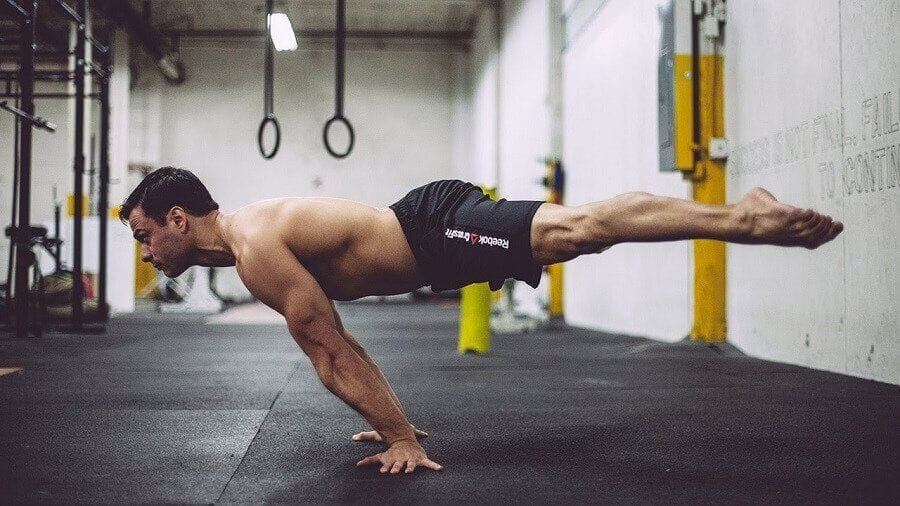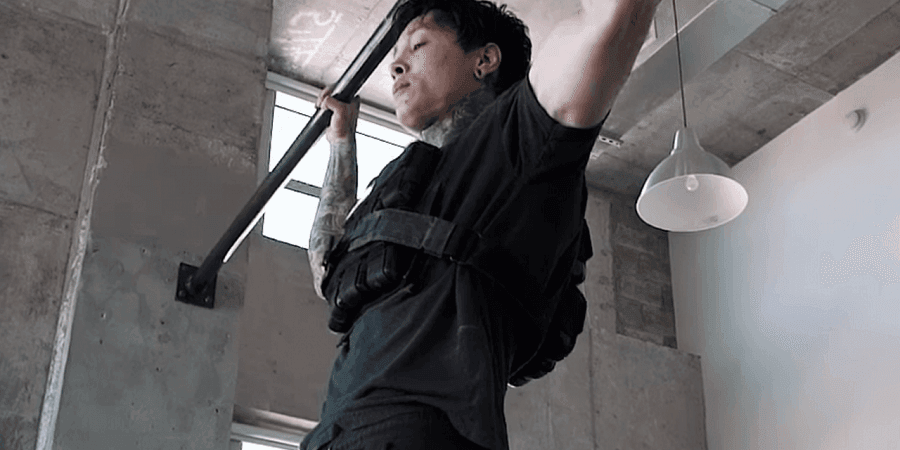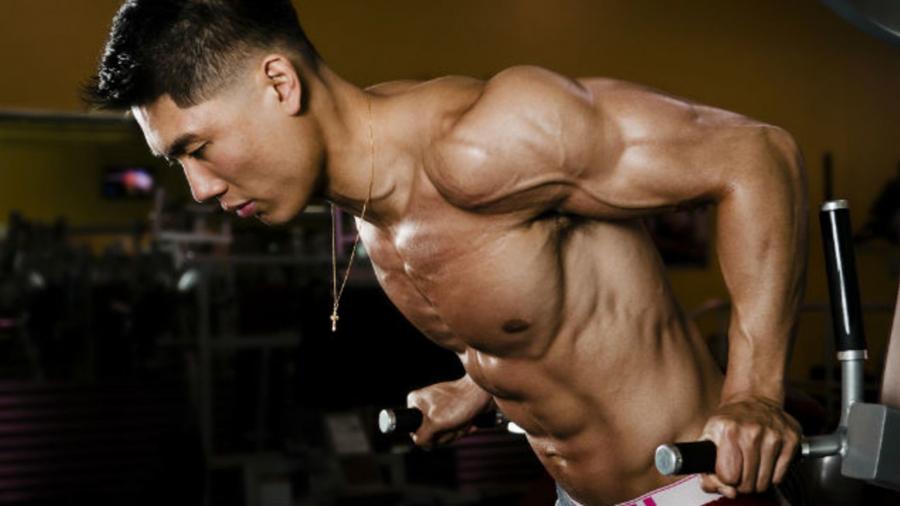Talk to anyone in the gym and they’ll tell you that in order to build muscle, you need to lift weights – and that’s true. However, what people don’t realise is that the weight doesn’t have to be barbells or dumbbells and instead can be your own bodyweight.
One of the most common myths in the fitness industry is that you have to follow a typical bodybuilding routine to get bigger. In actuality, there isn’t just one modus operandi, but a myriad of routes you can take in the pursuit of building a more capable body.
In this post we’re going to tackle the big question of whether you can build muscle with bodyweight exercises and also, how efficient they are at doing so.
Table of Contents
Can You Build Strength With Bodyweight Exercises?
Strength and size are two quite different things.
Sometimes people may look weak when in actuality they’re incredibly strong. For instance, take a look at gymnasts. In regular clothes, they might barely look like they lift, but give them some parallettes or rings and they can show you some near superhuman bodily feats.

Equally, some people can appear to be massive, but they’re so focused on getting a pump that they rarely move up in weight. You can get pretty big with very little knowledge about what you’re doing simply from eating lots and hitting the gym regularly.
Strength is based on the idea of progressive overload which is simply where you need to increase the stimulus placed upon your muscles over time to force them to adapt. If you stick with the same weight and the same volume, then there’s no reason for your body to get any bigger or stronger.
However, progressive overload isn’t just limited to weights. As we’ve said, all you need to do is increase the stimulus placed upon your body. As well as increasing the weight, you can also change the angle and the position of your body to place more emphasis on specific areas.
Let’s take a look at the push-up as an example. A good starting point is to do push-ups on your knees, then progress onto your toes. From here, you can move onto archer-push-ups, pike push-ups, clapping push-ups, and many other more difficult variations. By getting better at this movement and moving onto the progressions, you’ll be building strength in your chest, triceps, shoulders, and core. All that matters is that you keep your training challenging.
Can You Build Size With Bodyweight Exercises?
Whilst strength and size are two different things, they’re both conducive to each other’s goal.
Think of muscle as a glass and strength as water. Picture a table with two glasses of different sizes. You come along and pour 200ml into both. At this time, both the small glass and the large glass contain the same amount of water. However, if you kept pouring more and more water, there’s going to come a point where the small glass can’t hold anymore whilst the large glass still room to go.
In a similar fashion, a small muscle and a large muscle may have the same amount of strength, but a larger muscle has more potential to become stronger. Therefore, in the pursuit of strength, you should also include more volume work to increase the size of your muscles. Whilst not entirely accurate, weight does move weight, and the bigger you are, the stronger you can be.
To build strength, the focus should be on longer rest periods, lower reps, and higher loads. Something in the 1-4 rep range at around 85-90% of your 1 rep max. However, to train for size, the focus should still be on moving the most weight possible, but in the 6-20 rep range. It’s not that you won’t build any size doing lower reps, but it’s much easier to build muscle with lower loads and higher reps. In fact, anything up to 30 reps has been shown to increase size as long as you’re training to near failure and challenging yourself.
Now, in order to build size, you’re going to also need to get stronger which is why the two come hand in hand. The greater the loads you can use in your higher-rep training, the more volume you can complete, and the greater response you can get from your body.
Therefore, there’s no reason why bodyweight training can’t be used to build strength and size similar to normal bodybuilding. If you wanted to focus on size, then all you need to do is complete a small amount of strength-focused work and then use the majority of your session on building volume.
Let’s take a look at the dip. You might start with 3 sets of 1-3 reps with weight strapped around your waist and then finish off with 3 sets of 12 reps with a lower load or just at bodyweight. In the strength focused sets, rest for 3-5 minutes between sets and at a level of 2 RIR (Reps in Reserve i.e. how many reps you still have left in the tank). For your hypertrophy focused work, you would rest 60-120 seconds at a level of 3-1 RIR.
What Are The Drawbacks of Bodyweight Training For Strength And Size?
Although you can build strength and size with bodyweight training alone, that doesn’t necessarily make it a perfect route. There are definite downsides to bodyweight training which weight training doesn’t have, hence why many calisthenic artists will also spend some time in the gym to make up for it.
One of the biggest drawbacks is that progression isn’t always easy. Obviously, there’s no victory without first a great sacrifice. In the case of bodyweight training, the sacrifice with bodyweight training is always time and patience. With weight training, you can move up in small increments over time which provides motivation and small checkpoints in your way to a bigger goal. Going from a tuck planche to a full planche is much harder than going from an 80kg bench press to a 100kg bench press.
Because of this, it’s also harder to train based on auto-regulation. Auto-regulation is simply where you adjust the intensity of your session based upon how your mind and body are feeling. As there’s fewer progressions or adjustments for bodyweight training, you can’t slightly adjust the weight on the day; you’d have to change the movement.
It is possible to adjust the difficulty of a bodyweight exercise to an extent. This can be done by using a weighted vest or weighted dip belt to make it harder or by using resistance bands to make an exercise easier. Unfortunately, these methods are harder to measure than gym weights where you can simply increase or decrease weight in smaller set increments.

Lastly, the lack of variations can mean that it’s harder to train each body part specifically. With bodyweight training alone, you can’t isolate muscles as effectively. For example, you can’t just have an arm day as all of the bodyweight movements that train your arms also train your chest, shoulders, and back. Because of this, it can make it a lot harder to build up lagging muscles or get in enough volume in specific areas.
There are ways to shift the focus to place more emphasis on body parts, but not to isolate them completely.
What Are Some Benefits of Using Bodyweight to Train For Strength And Size?
It’s important to note that bodyweight training is often far more impressive. Being able to press a large load overhead certainly looks good, but being able to whip out some handstand press-ups at will is going to turn a lot more heads. Both take time and effort, both show a large amount of strength, but the latter is definitely more spectacular.
As well as this, transitioning from free weight training to bodyweight training isn’t easy. Just because you can move a certain amount of weight in the gym doesn’t mean you have the flexibility, stability, coordination or balance to pull off equivalent bodyweight moves. However, moving from bodyweight training to free-weight training is relatively much easier.
There are examples where people who have become proficient in dips, push-ups, and holds have started training with free weights only to be able to bench over one-and-a-half times their body weight in their first session. Yet, you rarely hear the opposite.
What Are The Best Bodyweight Exercises For Strength And Size?
Just because something is difficult or harder than another option doesn’t mean that it’s impossible, and bodyweight training is still an efficient and effective way to train your body. All it comes down to is picking the right exercises and working out how to fit them into your program. The principles of building strength and size aren’t restricted to the world of weight-lifting, and you can be extremely successful with bodybuilding using only your bodyweight.
In order to find out the right exercises, we’ll isolate your body into three areas: muscles that push, muscles that pull, and then your legs. Muscles that push will be your chest, shoulders, and triceps, muscles that pull will be your back and biceps, and then your legs will be, well, your legs.
We’ll also tack on a section at the end specifically for the lower back and abs. However, most bodyweight exercises train these muscles already. A push-up requires much more stabilisation by the core than a bench press, so you won’t need to do as much direct ab work as you might think. Regardless, core work can be a great addition to your training as accessory work to improve your other lifts.
Push:
- Dips
- Push-ups
- Plyometric push-ups
- One-arm push-ups
- Archer push-ups
- Handstand push-ups
- Diamond push-ups
- Planche
- Pike push-ups
- Uneven push-ups
Pull:
- Pull-ups
- Chin-ups
- Muscle-ups
- Bodyweight rows
Legs:
- Bodyweight Squats
- Lunges
- Pistol Squats
- Shrimp squats
- Jumps
- Hip Thrusts
- Russian leg curl
Abs and Lower back:
- Plank
- Pike rollouts
- L-sits
- Leg Raises
- Windmills
- Windscreen wipers
- Burpee
- Bicycle crunch
- Russian twists
How Should I Train For Strength And Size?
Much of the same advice for bodybuilding training you can take and use with calisthenics. You don’t need to do body part splits as not only can you not directly train each muscle with bodyweight training, but splits don’t provide enough frequency or stimulus to grow.
There are two ways you can separate your training:
- Full-body
- Area-splits
Full-body requires less training sessions, but each training session you make sure to train at least one push, pull, leg, and core movement. Area-splits cut your training into push, pull, and legs with some core work added onto the end of these. The latter option will mean that you train more often but can hit each area with more intensity whilst the first option is better suited to those who have a busy schedule and can’t train as much.
You can make progress with both, so it really just comes down to which suits your lifestyle best.
Final Thoughts
At the end of the day, if you’re continually challenging your body, then it’s going to adapt, and all you have to do is use methods related to the adaptation that you want.
If you want your muscles to grow, then you’re going to need to challenge them through sets, reps, and weight.
Whether you do this through free weights or your own bodyweight comes down to personal preference. It comes down to you to weigh up the pros and cons of each and make a decision about which route you want to take.

Founder of www.calisthenics-101.co.uk. Training calisthenics since 2012.
Currently working on: 30 second one-arm handstand, muscle-up 360, straddle planche.
